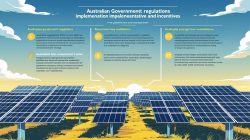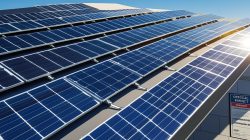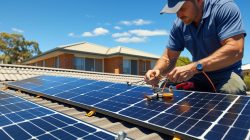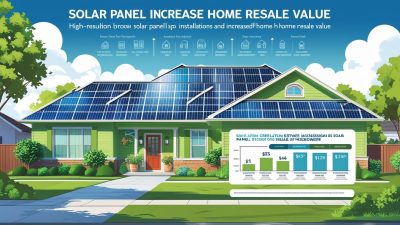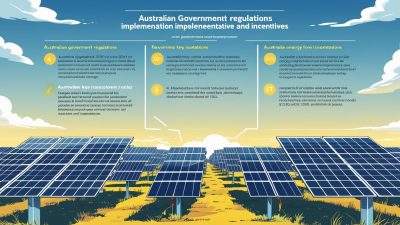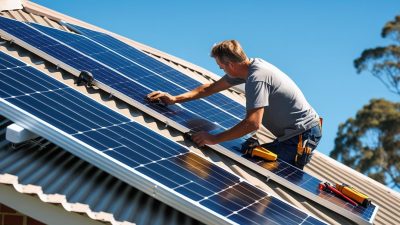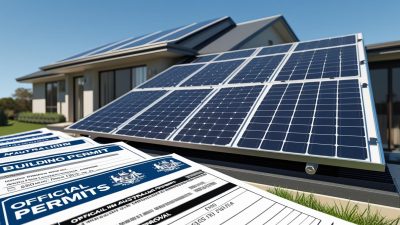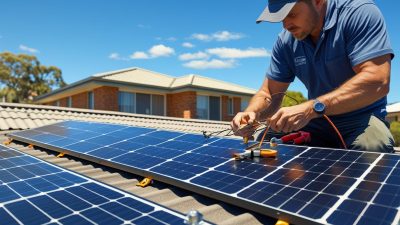How a Solar Farm Works in Australia
Bloggerbanyumas.com -How a Solar Farm Works in Australia In Australia, solar farms have quickly become a cornerstone of the country’s commitment to renewable energy. The Australian government and energy companies are prioritizing the expansion of solar power as part of the nation’s goal to reduce carbon emissions and transition to a sustainable energy future. By 2025, solar farms are expected to play an even greater role in supplying clean, renewable energy to homes, businesses, and industries across the country. Understanding how solar farms work is crucial for both energy consumers and developers alike, especially in a rapidly evolving energy market. This comprehensive guide provides an in-depth look at how solar farms operate in Australia, the technology behind them, and what the future holds for solar energy in the region.
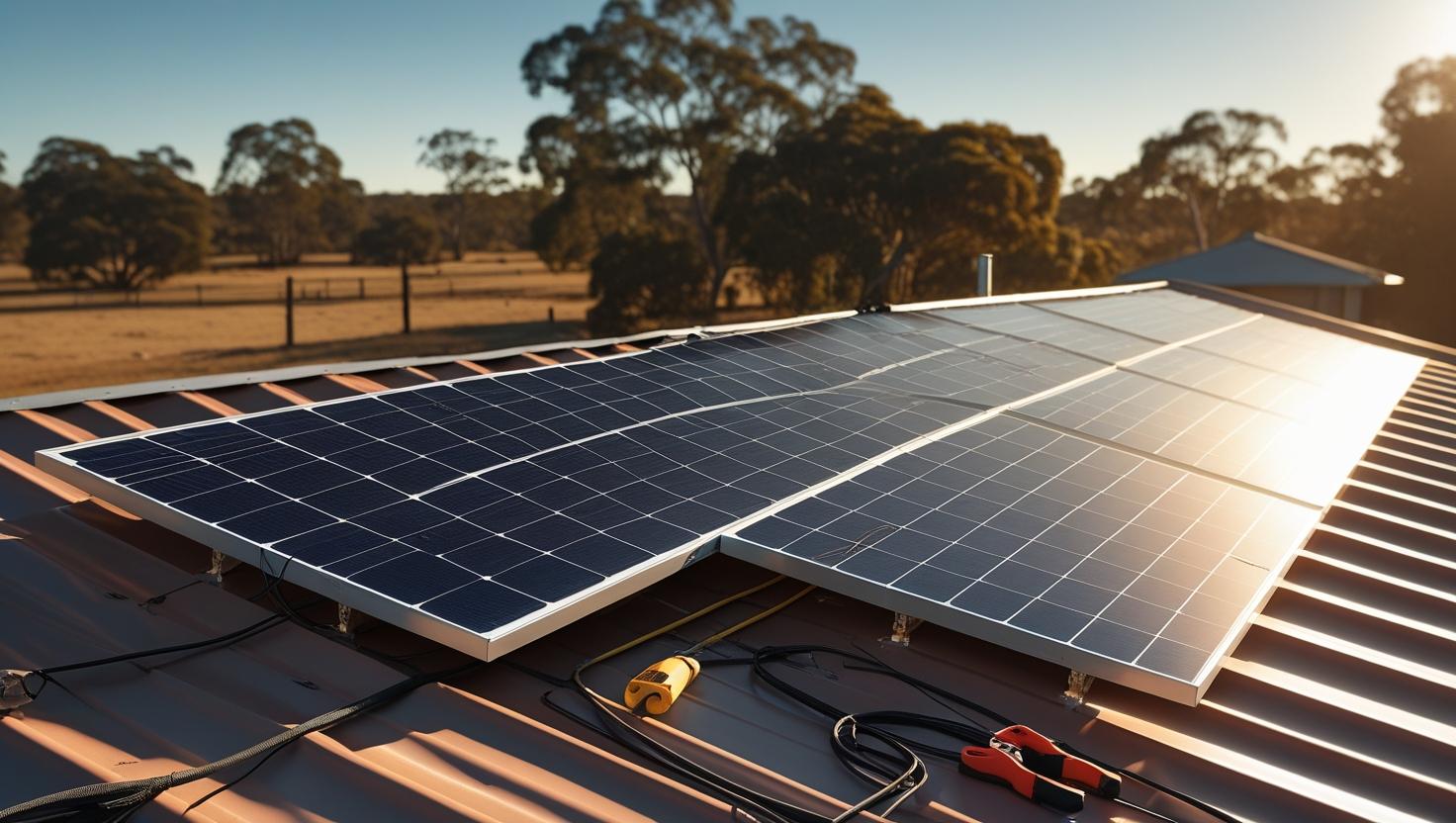
The Role of Solar Farms in Australia’s Energy Transition
Solar farms in Australia are essential to achieving the country’s ambitious energy goals. Australia’s abundant sunshine makes it an ideal location for solar energy generation. Solar farms harness this natural resource by converting sunlight into electricity, which is then fed into the national grid. These solar facilities are scalable, meaning they can vary in size, from small community solar projects to massive utility-scale plants generating hundreds of megawatts of electricity. As solar energy becomes a central part of Australia’s energy mix, solar farms will be crucial to meeting the country’s growing energy demands and reducing reliance on fossil fuels.
Why Solar Farms are Crucial for Australia’s Future
As we approach 2025, Australia’s need for large-scale solar energy generation is more pressing than ever. The country aims to reduce carbon emissions and meet its net-zero targets by mid-century. Solar farms provide an effective solution to these goals by generating clean, renewable energy without harmful emissions. The expansion of solar energy not only supports environmental sustainability but also helps to stimulate the economy by creating jobs in installation, maintenance, and operation of solar facilities. Furthermore, solar farms contribute to energy security by diversifying Australia’s power generation portfolio and reducing dependence on imported fuels.
The Technology Behind Solar Farms in Australia
The operation of a solar farm involves several key technologies that work together to efficiently capture, convert, and store sunlight. These technologies have advanced significantly over the past decade, enabling solar farms in Australia to produce increasingly more energy at lower costs. Below is a detailed look at the primary components of a solar farm and how they work together to produce electricity.
Photovoltaic (PV) Panels: The Heart of a Solar Farm
At the core of any solar farm are the photovoltaic (PV) panels, which are responsible for converting sunlight into electricity. These panels are made up of multiple solar cells that use the photoelectric effect to generate electrical current when exposed to sunlight. The efficiency of the panels has improved over the years, with the latest models achieving conversion rates of over 20%. In Australia, solar farms typically use monocrystalline or polycrystalline silicon panels, which are known for their durability and high performance.
Each solar cell consists of two layers of semiconductor material. When sunlight strikes the panel, it excites electrons in the semiconductor, generating an electrical current. This current is then collected by wiring within the panels and routed to an inverter, where it is converted from direct current (DC) electricity to alternating current (AC) electricity, which is the form of electricity used by homes and businesses.
Panel Efficiency and Output
The size of the solar farm directly correlates to the amount of electricity it can produce. A typical utility-scale solar farm in Australia can have thousands or even millions of individual solar panels, and depending on its size, it can generate anywhere from 10 MW to over 500 MW of electricity. The total energy output of a solar farm is influenced by several factors, including the type of panels used, the geographic location of the farm, the angle and orientation of the panels, and the weather conditions.
Inverters: Converting DC to AC Electricity
Once the solar panels generate electricity in the form of DC power, this electricity must be converted to AC power before it can be fed into the electricity grid. Inverters are the devices that perform this crucial function. Inverters are strategically placed in the solar farm to handle the conversion of DC power from each group of solar panels.
Modern inverters are highly efficient, and they are equipped with features that allow them to track and optimize the performance of the solar panels. These devices ensure that the farm is generating the maximum amount of electricity possible by adjusting for variations in sunlight and shading throughout the day. Inverters also help ensure the quality of the electricity being fed into the grid, preventing fluctuations or power quality issues.
Transformers and Grid Connection: Delivering Power to the Grid
After the electricity is converted to AC by the inverters, it travels through transformers that increase its voltage to match the voltage of the electricity grid. This is necessary to ensure that the power generated by the solar farm can be efficiently transmitted over long distances without losing energy.
The transformed electricity is then fed into the transmission lines that carry it to the grid. In Australia, the national electricity grid is managed by various operators, such as the Australian Energy Market Operator (AEMO). The grid distributes the electricity to homes and businesses across the country, ensuring a reliable and consistent supply of power. Solar farms are connected to the grid via substations, which facilitate the transfer of energy from the farm to the larger electrical infrastructure.
Energy Storage: Enhancing Reliability and Flexibility
In many cases, solar farms in Australia are paired with energy storage systems, such as batteries, to store excess electricity generated during the day for use during the night or on cloudy days. This is particularly important in regions where solar energy generation may be intermittent, such as in areas with variable weather or during nighttime hours.
Energy storage systems help smooth out the supply of electricity and ensure that solar farms can provide power even when the sun is not shining. Advanced battery technologies, such as lithium-ion and flow batteries, are increasingly being used in conjunction with solar farms to provide a more reliable and flexible energy solution.
Monitoring and Maintenance: Ensuring Maximum Efficiency
To ensure that a solar farm operates at peak efficiency, constant monitoring and maintenance are required. Solar farms are equipped with sophisticated monitoring systems that track the performance of each solar panel, inverter, and transformer. These systems provide real-time data on energy production, allowing operators to identify potential issues and perform maintenance as needed.
Routine maintenance tasks for solar farms typically include cleaning the solar panels to remove dirt and debris that could reduce their efficiency, inspecting electrical connections, and ensuring that the inverters are functioning properly. While solar farms require less maintenance than conventional power plants, regular upkeep is crucial to maximize energy output and extend the lifespan of the equipment.
The Benefits of Solar Farms in Australia
The expansion of solar farms in Australia offers numerous benefits, both for the environment and the economy. Below, we explore the key advantages of solar energy and why solar farms are integral to Australia’s future energy landscape.
Environmental Benefits
One of the primary reasons for the rapid growth of solar farms in Australia is their environmental impact. Solar farms produce clean, renewable energy without emitting harmful greenhouse gases. By transitioning to solar power, Australia can significantly reduce its carbon footprint and contribute to global efforts to mitigate climate change.
Additionally, solar energy is a sustainable source of power. Unlike fossil fuels, which are finite and polluting, sunlight is an abundant and renewable resource. Solar farms harness this energy to generate electricity without depleting natural resources or damaging ecosystems.
Economic Benefits
Solar farms also provide significant economic benefits for Australia. By investing in large-scale solar projects, the country can reduce its reliance on imported energy and fossil fuels, ultimately improving energy security. Solar energy also contributes to job creation, particularly in the construction, operation, and maintenance of solar farms. The growth of the solar industry has led to a rise in employment opportunities, including roles in manufacturing, installation, and energy management.
Moreover, solar farms can generate substantial economic returns for landowners. Many solar developers enter into land lease agreements with property owners, offering them a steady income stream in exchange for using their land for solar installations. This arrangement provides financial benefits to rural and regional communities, where large areas of land are often available for solar farm development.
Reducing Energy Costs
As the cost of solar energy continues to decline, solar farms offer a cost-effective solution for meeting Australia’s growing energy demand. Solar energy generation is now often cheaper than traditional fossil fuel-based electricity generation, making it a competitive option for both private and commercial consumers. Over time, the widespread adoption of solar energy can help reduce electricity prices for Australian consumers, providing long-term savings for households and businesses alike.
Energy Independence and Security
By investing in domestic renewable energy resources like solar farms, Australia can reduce its dependence on foreign energy supplies, particularly fossil fuels. This energy independence enhances national security and shields the country from fluctuations in global energy prices. Solar energy also provides a diversified energy mix, making the country’s electricity grid more resilient to disruptions and more capable of handling fluctuating demand.
The Future of Solar Farms in Australia: What to Expect by 2025
Looking ahead to 2025, solar farms in Australia are set to become even more efficient and widespread. As technology advances, solar panels will become more efficient at converting sunlight into electricity, reducing the amount of land required for solar farms while increasing energy production. Additionally, innovations in energy storage and smart grid technologies will enhance the ability of solar farms to provide reliable, consistent power.
Australia’s solar industry is also expected to grow as governments, both state and federal, continue to provide support for renewable energy projects. With increasing investment, solar farms will continue to play a critical role in Australia’s transition to a low-carbon economy. By 2025, solar power is poised to become a dominant force in Australia’s energy future, helping the country achieve its climate goals while providing affordable, clean energy for all.
Conclusion
As we approach 2025, solar farms will play an increasingly vital role in Australia’s energy landscape. These facilities harness the power of the sun to provide clean, sustainable electricity that will help Australia meet its climate targets and reduce its reliance on fossil fuels. With advanced technology, large-scale deployment, and ongoing support from the government, solar farms are well-positioned to contribute to Australia’s energy future for years to come. As the country moves toward a greener, more sustainable energy system, solar farms will continue to shine as a beacon of innovation and environmental responsibility.


